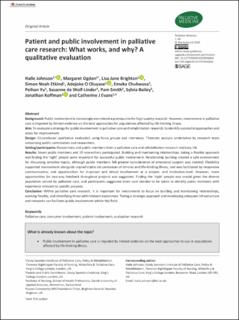Please use this identifier to cite or link to this item:
https://doi.org/10.21256/zhaw-20725Full metadata record
| DC Field | Value | Language |
|---|---|---|
| dc.contributor.author | Johnson, Halle | - |
| dc.contributor.author | Ogden, Margaret | - |
| dc.contributor.author | Brighton, Lisa Jane | - |
| dc.contributor.author | Etkind, Simon Noah | - |
| dc.contributor.author | Oluyase, Adejoke O | - |
| dc.contributor.author | Chukwusa, Emeka | - |
| dc.contributor.author | Yu, Peihan | - |
| dc.contributor.author | de Wolf-Linder, Susanne | - |
| dc.contributor.author | Smith, Pam | - |
| dc.contributor.author | Bailey, Sylvia | - |
| dc.contributor.author | Koffman, Jonathan | - |
| dc.contributor.author | Evans, Catherine J | - |
| dc.date.accessioned | 2020-10-29T13:29:47Z | - |
| dc.date.available | 2020-10-29T13:29:47Z | - |
| dc.date.issued | 2020-09-11 | - |
| dc.identifier.issn | 0269-2163 | de_CH |
| dc.identifier.issn | 1477-030X | de_CH |
| dc.identifier.uri | https://digitalcollection.zhaw.ch/handle/11475/20725 | - |
| dc.description.abstract | Background: Public involvement is increasingly considered a prerequisite for high-quality research. However, involvement in palliative care is impeded by limited evidence on the best approaches for populations affected by life-limiting illness. Aim: To evaluate a strategy for public involvement in palliative care and rehabilitation research, to identify successful approaches and areas for improvement.Design: Co-produced qualitative evaluation using focus groups and interviews. Thematic analysis undertaken by research team comprising public contributors and researchers. Setting/participants: Researchers and public members from a palliative care and rehabilitation research institute, UK. Results: Seven public members and 19 researchers participated. Building and maintaining relationships, taking a flexible approach and finding the ‘right’ people were important for successful public involvement. Relationship building created a safe environment for discussing sensitive topics, although public members felt greater consideration of emotional support was needed. Flexibility supported involvement alongside unpredictable circumstances of chronic and life-limiting illness, and was facilitated by responsive communication, and opportunities for in-person and virtual involvement at a project- and institution-level. However, more opportunities for two-way feedback throughout projects was suggested. Finding the ‘right’ people was crucial given the diverse population served by palliative care, and participants suggested more care needed to be taken to identify public members with experience relevant to specific projects. Conclusion: Within palliative care research, it is important for involvement to focus on building and maintaining relationships, working flexibly, and identifying those with relevant experience. Taking a strategic approach and developing adequate infrastructure and networks can facilitate public involvement within this field. | de_CH |
| dc.language.iso | en | de_CH |
| dc.publisher | Sage | de_CH |
| dc.relation.ispartof | Palliative Medicine | de_CH |
| dc.rights | http://creativecommons.org/licenses/by/4.0/ | de_CH |
| dc.subject | Palliative care | de_CH |
| dc.subject | Consumer involvement | de_CH |
| dc.subject | Evaluation research | de_CH |
| dc.subject | Patient involvement | de_CH |
| dc.subject.ddc | 610.73: Pflege | de_CH |
| dc.title | Patient and public involvement in palliative care research : what works, and why? A qualitative evaluation | de_CH |
| dc.type | Beitrag in wissenschaftlicher Zeitschrift | de_CH |
| dcterms.type | Text | de_CH |
| zhaw.departement | Gesundheit | de_CH |
| zhaw.organisationalunit | Institut für Pflege (IPF) | de_CH |
| dc.identifier.doi | 10.1177/0269216320956819 | de_CH |
| dc.identifier.doi | 10.21256/zhaw-20725 | - |
| dc.identifier.pmid | 32912087 | de_CH |
| zhaw.funding.eu | No | de_CH |
| zhaw.issue | 1 | de_CH |
| zhaw.originated.zhaw | Yes | de_CH |
| zhaw.pages.end | 160 | de_CH |
| zhaw.pages.start | 151 | de_CH |
| zhaw.publication.status | publishedVersion | de_CH |
| zhaw.volume | 35 | de_CH |
| zhaw.publication.review | Peer review (Publikation) | de_CH |
| zhaw.author.additional | No | de_CH |
| zhaw.display.portrait | Yes | de_CH |
| Appears in collections: | Publikationen Gesundheit | |
Files in This Item:
| File | Description | Size | Format | |
|---|---|---|---|---|
| 2020_Johnson-etal_Patient-and-public-involvement-in-palliative-care-research.pdf | 672.74 kB | Adobe PDF |  View/Open |
Show simple item record
Johnson, H., Ogden, M., Brighton, L. J., Etkind, S. N., Oluyase, A. O., Chukwusa, E., Yu, P., de Wolf-Linder, S., Smith, P., Bailey, S., Koffman, J., & Evans, C. J. (2020). Patient and public involvement in palliative care research : what works, and why? A qualitative evaluation. Palliative Medicine, 35(1), 151–160. https://doi.org/10.1177/0269216320956819
Johnson, H. et al. (2020) ‘Patient and public involvement in palliative care research : what works, and why? A qualitative evaluation’, Palliative Medicine, 35(1), pp. 151–160. Available at: https://doi.org/10.1177/0269216320956819.
H. Johnson et al., “Patient and public involvement in palliative care research : what works, and why? A qualitative evaluation,” Palliative Medicine, vol. 35, no. 1, pp. 151–160, Sep. 2020, doi: 10.1177/0269216320956819.
JOHNSON, Halle, Margaret OGDEN, Lisa Jane BRIGHTON, Simon Noah ETKIND, Adejoke O OLUYASE, Emeka CHUKWUSA, Peihan YU, Susanne DE WOLF-LINDER, Pam SMITH, Sylvia BAILEY, Jonathan KOFFMAN und Catherine J EVANS, 2020. Patient and public involvement in palliative care research : what works, and why? A qualitative evaluation. Palliative Medicine. 11 September 2020. Bd. 35, Nr. 1, S. 151–160. DOI 10.1177/0269216320956819
Johnson, Halle, Margaret Ogden, Lisa Jane Brighton, Simon Noah Etkind, Adejoke O Oluyase, Emeka Chukwusa, Peihan Yu, et al. 2020. “Patient and Public Involvement in Palliative Care Research : What Works, and Why? A Qualitative Evaluation.” Palliative Medicine 35 (1): 151–60. https://doi.org/10.1177/0269216320956819.
Johnson, Halle, et al. “Patient and Public Involvement in Palliative Care Research : What Works, and Why? A Qualitative Evaluation.” Palliative Medicine, vol. 35, no. 1, Sept. 2020, pp. 151–60, https://doi.org/10.1177/0269216320956819.
Items in DSpace are protected by copyright, with all rights reserved, unless otherwise indicated.